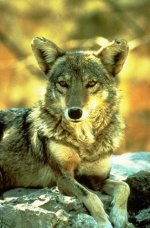 The coyote (Canis latrans) can only be found in North America. Besides the raccoon, it is one of few animals that increased their population with human settlement. They are occupying territories formerly owned by wolves and are feeding on garbage in urban areas. Despite their underfed appearance, that is just the way they look, much smaller than the gray wolf, their close relative. Coyotes can hybridize with gray wolves and domestic dogs. Watch a movie on coyotes here.
The coyote (Canis latrans) can only be found in North America. Besides the raccoon, it is one of few animals that increased their population with human settlement. They are occupying territories formerly owned by wolves and are feeding on garbage in urban areas. Despite their underfed appearance, that is just the way they look, much smaller than the gray wolf, their close relative. Coyotes can hybridize with gray wolves and domestic dogs. Watch a movie on coyotes here.
Keywords: paw
The American jackal, brush wolf, coyote, prairie wolf is listed as Least Concern. Does not qualify for a more at risk category. Widespread and abundant taxa are included in this category, on the IUCN Red List of Threatened Species
Namings for the coyote
A young / baby of a coyote is called a 'cub, pup or whelp'. The females are called 'bitch' and males 'dog'. A coyote group is called a 'pack or train'.Countries
Belize, Canada, Costa Rica, El Salvador, Guatemala, Honduras, Mexico, Nicaragua, Panama and United StatesCoyote habitats
Arable Land, Artificial / Terrestrial, Bogs, Marshes, Swamps, Fens, Peatlands, Boreal forest, Desert, Forest, Grassland, Hot Desert, Moist savanna, Pastureland, Savanna, Shrubland, Subtropical / Tropical Dry forest, Subtropical / Tropical Dry Grassland, Subtropical / Tropical Dry Shrubland, Subtropical / Tropical High Altitude Grassland, Subtropical / Tropical Moist Lowland, Subtropical / Tropical Moist Shrubland, Temperate Desert, Temperate forest, Temperate Grassland, Temperate Shrubland, Urban Areas and Wetlands (inland)Some facts about the
Coyote
Adult weight : 13.25 kg (29.15 lbs)
Maximum longevity : 22 years
Female maturity :274 days
Male maturity : 274 days
Gestation : 63 days
Weaning : 60 days
Litter size : 6
Litters per year : 1
Interval between litters : 365 days
Weight at birth : 0.25 kg (0.55 lbs)
Weight at weaning : 1.517 kg (3.3374 lbs)
Basal metabolic rate : 19 W
Body mass : 10.149 kg (22.3278 lbs)
Temperature : 36.85 °C (98.33 °F)

Custom Search